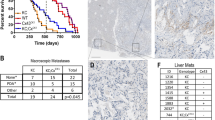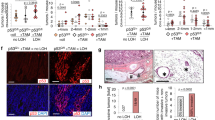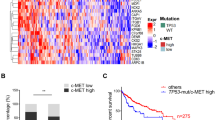Abstract
Connexin32 knockout mice (Cx32-KO) exhibit increased chemical- and radiation-induced liver and lung tumor formation with many lung tumors demonstrating decreased levels of the tumor suppressor p27KIP1. To determine if p27 deficiency alters Cx32-influenced tumorigenesis, we have generated a Cx32/p27 double-deficient mouse strain (DKO) and show here that exposure of these mice to X-ray radiation resulted in an increase or decrease in tumorigenesis depending on the tissue. Several tissues were highly sensitive to loss of p27 tumor suppressor function (intestine, adrenal, pituitary) resulting in an increased overall tumor burden in DKO mice compared to both wild-type (P<0.005) and Cx32-KO mice (P=0.066). However, additional deletion of p27 in a Cx32-KO background resulted in a statistically significant decrease in the liver tumor incidence suggesting that Cx32 and p27 pathways mechanistically interact. Immunohistochemical analysis revealed an increased percentage of Cx32-KO liver and lung tumors harboring active mitogen-activated protein kinase (Erk1, Erk2) pathways in contrast to lower percentages of activated wild-type (P<0.005) and DKO tumors (P=0.027). Increased MAPK activation in liver tumors did not correlate with Ha-ras codon-61 mutation status. This study demonstrates that tissues dependent on Cx32 tumor suppression, such as the liver and lung, exhibit altered tumorigenesis and tumor biology (MAPK pathway activation) related to p27 status.
This is a preview of subscription content, access via your institution
Access options
Subscribe to this journal
Receive 50 print issues and online access
$259.00 per year
only $5.18 per issue
Buy this article
- Purchase on Springer Link
- Instant access to full article PDF
Prices may be subject to local taxes which are calculated during checkout




Similar content being viewed by others
References
Abraham V, Chou ML, George P, Pooler P, Zaman A, Savani RC and Koval M . (2001). Am. J. Physiol. – Lung Cell. Mol. Physiol., 280, L1085–1093.
Avanzo JL, Mesnil M, Hernandez-Blazquez FJ, Mackowiak II, Mori CM, Da Silva TC, Oloris SC, Garate AP, Massironi SM, Yamasaki H and Dagli ML . (2004). Carcinogenesis, 25, 1973–1982.
Aydinlik H, Nguyen TD, Moennikes O, Buchmann A and Schwarz M . (2001). Oncogene., 20, 7812–7816.
Defamie N, Berthaut I, Mograbi B, Chevallier D, Dadoune JP, Fenichel P, Segretain D and Pointis G . (2003). Lab. Invest., 83, 449–456.
Evert M, Ott T, Temme A, Willecke K and Dombrowski F . (2002). Carcinogenesis, 23, 697–703.
Fero ML, Randel E, Gurley KE, Roberts JM and Kemp CJ . (1998). Nature, 396, 177–180.
Fero ML, Rivkin M, Tasch M, Porter P, Carow CE, Firpo E, Polyak K, Tsai LH, Broudy V, Perlmutter RM, Kaushansky K and Roberts JM . (1996). Cell, 85, 733–744.
Hanna EA, Umhauer S, Roshong SL, Piechocki MP, Fernstrom MJ, Fanning JD and Ruch RJ . (1999). Carcinogenesis, 20, 1369–1373.
King TJ, Fukushima LH, Hieber AD, Shimabukuro KA, Sakr WA and Bertram JS . (2000). Carcinogenesis, 21, 1097–1109.
King TJ, Fukushima LH, Yasui Y, Lampe PD and Bertram JS . (2002). Mol. Carcinogen., 35, 29–41.
King TJ and Lampe PD . (2004a). Cancer Res., 64, 7191–7196.
King TJ and Lampe PD . (2004b). Carcinogenesis, 25, 669–680.
Koffler L, Roshong S, Kyu Park I, Cesen-Cummings K, Thompson DC, Dwyer-Nield LD, Rice P, Mamay C, Malkinson AM and Ruch RJ . (2000). J. Cell. Biochem., 79, 347–354.
Koval M . (2002). Am. J. Physiol. – Lung Cell. Mol. Physiol., 283, L875–L893.
Krutovskikh V and Yamasaki H . (2000). Mutat. Res., 462, 197–207.
Lloyd RV, Erickson LA, Jin L, Kulig E, Qian X, Cheville JC and Scheithauer BW . (1999). Am. J. Pathol., 154, 313–323.
Lo CW . (1999). Dev. Genet., 24, 1–4.
Lumniczky K, Antal S, Unger E, Wunderlich L, Hidvegi EJ and Safrany G . (1998). Mol. Carcinogen., 21, 100–110.
Maronpot RR . (1999). Pathology of the Mouse 1st edn. Cache River Press: Vienna, IL.
Mehta PP, Perez-Stable C, Nadji M, Mian M, Asotra K and Roos BA . (1999). Dev. Genet., 24, 91–110.
Mesnil M . (2002). Biol. Cell., 94, 493–500.
Moennikes O, Buchmann A, Ott T, Willecke K and Schwarz M . (1999). Carcinogenesis, 20, 1379–1382.
Muraoka RS, Lenferink AE, Simpson J, Brantley DM, Roebuck LR, Yakes FM and Arteaga CL . (2001). J. Cell. Biol., 153, 917–932.
Nelles E, Butzler C, Jung D, Temme A, Gabriel HD, Dahl U, Traub O, Stumpel F, Jungermann K, Zielasek J, Toyka KV, Dermietzel R and Willecke K . (1996). Proc. Natl. Acad. Sci. USA, 93, 9565–9570.
Philipp-Staheli J, Kim KH, Liggitt D, Gurley KE, Longton G and Kemp CJ . (2004). Oncogene, 23, 905–913.
Philipp-Staheli J, Kim KH, Payne SR, Gurley KE, Liggitt D, Longton G and Kemp CJ . (2002). Cancer Cell, 1, 355–368.
Philipp-Staheli J, Payne SR and Kemp CJ . (2001). Exp. Cell Res., 264, 148–168.
Ramakrishna G, Perella C, Birely L, Diwan BA, Fornwald LW and Anderson LM . (2002). Toxicol. Appl. Pharmacol., 179, 21–34.
Richard G . (2001). Adv. Dermatol., 17, 243–277.
Ruch RJ, Cesen-Cummings K and Malkinson AM . (1998). Exp. Lung Res., 24, 523–539.
Scherer SS, Xu YT, Nelles E, Fischbeck K, Willecke K and Bone LJ . (1998). GLIA, 24, 8–20.
Schwarz M, Wanke I, Wulbrand U, Moennikes O and Buchmann A . (2003). Toxicol. Pathol., 31, 99–102.
Sherr CJ and Roberts JM . (1999). Genes Dev., 13, 1501–1512.
Temme A, Buchman A, Babriel HC, Nelles E, Scharz M and Willecke K . (1997). Curr. Biol., 7, 713–718.
Temme A, Stumpel F, Sohl G, Rieber EP, Jungermann K, Willecke K and Ott T . (2001). Pflugers Archiv – Eur. J. Physiol., 442, 961–966.
Trosko JE and Ruch RJ . (1998). Front. Biosci., 3, 208–236.
Upham BL, Rummel AM, Carbone JM, Trosko JE, Ouyang Y, Crawford RB and Kaminski NE . (2003). Int. J. Cancer, 104, 12–18.
Warn-Cramer BJ, Cottrell GT, Burt JM and Lau AF . (1998). J. Biol. Chem., 273, 9188–9196.
Warn-Cramer BJ, Lampe PD, Kurata WE, Kanemitsu MY, Loo LWM, Eckhart W and Lau AF . (1996). J. Biol. Chem., 271, 3779–3786.
Willecke K, Eiberger J, Degen J, Eckardt D, Romualdi R, Guldenagel M, Deutsch U and Sohl G . (2002). Biol. Chem., 383, 725–737.
Yao R, Wang Y, Lubet RA and You M . (2003). Neoplasia (New York), 5, 41–52.
Zhang YW, Morita I, Ikeda M, Ma KW and Murota S . (2001). Oncogene, 20, 4138–4149.
Zhang YW, Nakayama K and Morita I . (2003). Cancer Res., 63, 1623–1630.
Acknowledgements
Thanks to Steven Scherer (Philadelphia, PA, USA) for providing Cx32-KO mice. This work was supported by NIH Grants AR47963, GM55632 (PDL). TJK was a recipient of an Institutional NIH-T32 Postdoctoral Research Training Grant (T32-AI07509).
Author information
Authors and Affiliations
Corresponding author
Rights and permissions
About this article
Cite this article
King, T., Gurley, K., Prunty, J. et al. Deficiency in the gap junction protein Connexin32 alters p27Kip1 tumor suppression and MAPK activation in a tissue-specific manner. Oncogene 24, 1718–1726 (2005). https://doi.org/10.1038/sj.onc.1208355
Received:
Revised:
Accepted:
Published:
Issue Date:
DOI: https://doi.org/10.1038/sj.onc.1208355
Keywords
This article is cited by
-
Cx43 phosphorylation sites regulate pancreatic cancer metastasis
Oncogene (2021)
-
Therapeutic strategies targeting connexins
Nature Reviews Drug Discovery (2018)
-
The lung communication network
Cellular and Molecular Life Sciences (2015)
-
Implications and challenges of connexin connections to cancer
Nature Reviews Cancer (2010)
-
Revisiting the Stimulus-Secretion Coupling in the Adrenal Medulla: Role of Gap Junction-Mediated Intercellular Communication
Molecular Neurobiology (2009)



